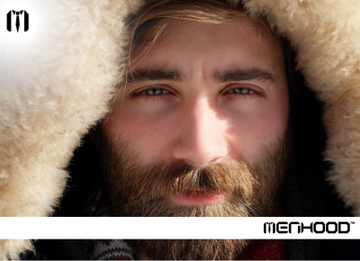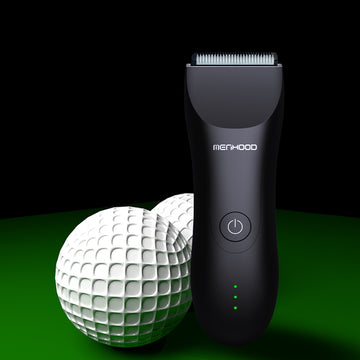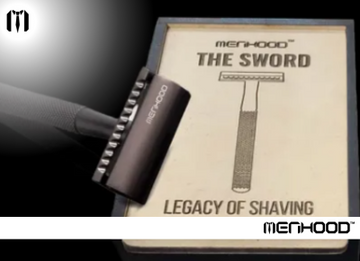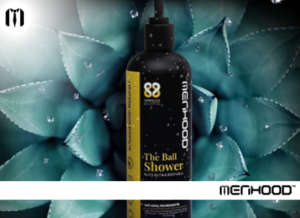Beard trimming is a crucial part of maintaining an attractive and healthy-looking beard. But how does beard trimming affect growth?
The answer is yes - beard trimming can help promote growth, but how you trim your beard is just as important. When it comes to maintaining a healthy-looking and attractive beard, proper trimming techniques are paramount. Trimming too much or too little could result in an uneven or patchy-looking beard.
In this article, we'll share tips and tricks for trimming your beard to help you get the most out of your growth journey.
The Beard Growth Cycle
Understanding the beard growth cycle is essential to get the most out of your beard trimming. The average beard follows a three-stage process:
1. Anagen Phase
The Anagen phase is the exploration stage of the beard. This is when your facial hair grows from its follicles and starts to fill in, getting thicker and darker as it does so. During this phase, it's important to avoid trimming or shaping your beard too much, as this can cause damage to the fragile new hairs. If you must trim during this stage, do so lightly - no more than a millimeter or two.
2. Catagen Phase
The Catagen phase marks the transitional period between the active growth phase (Anagen) and the resting phase (Telogen) of your beard hairs, signaling a pause in their growth. You can trim off any split ends or excess hair during this phase. The Menhood™ Grooming Trimmer 1.0 is perfect for this purpose - its Ceramic Blade Technology is designed to gently trim away split ends without damaging or snagging the hair.

3. Telogen Phase
The Telogen phase marks the end of the beard growth cycle and is when your hair starts to fall out naturally, making way for a new growth cycle. Your beard hairs are no longer growing at this stage, so trimming is unnecessary.
Factors Influencing Beard Growth
Here are some of the factors that can influence how fast and thick your beard grows:
1. Genetics
Genetics plays a pivotal role in determining your beard's thickness and growth pattern. The genes inherited from your parents influence your beard's density, color, and even shape. If your family has a thick and U-shaped beard history, you will likely have similar facial hair characteristics.
However, genetics also determine your hair's growth cycle. Hair follicles undergo phases of growth, rest, and shedding. Beard hair growth is primarily determined by the length of the growth phase (anagen). While you can't change your genetics, you can optimize other factors to maximize your beard potential.
2. Hormones
Hormones, particularly testosterone and dihydrotestosterone (DHT), significantly impact beard growth. During puberty, an increase in these hormones triggers facial hair development. Testosterone converts to DHT, which stimulates the growth of terminal (thicker and longer) beard hairs.
The balance of these hormones varies from person to person. Some individuals naturally have higher levels of testosterone and DHT, which can lead to more robust beard growth. In contrast, others may have lower levels, resulting in slower or thinner growth.
3. Diet and Nutrition
Your diet and overall nutrition can influence beard growth as well. Hair, including facial hair, is made of a protein called keratin. Ensuring adequate protein, vitamins, and minerals intake is essential for healthy beard growth.
A well-balanced diet rich in vitamins like Biotin (B7), Niacin (B3), and Vitamin C can support the growth of strong and resilient beard hair. Additionally, minerals like zinc and iron play a role in maintaining healthy hair follicles.
4. Lifestyle
Your lifestyle also has an impact on beard growth. Smoking, drinking alcohol, and stress can interfere with the balance of hormones in your body and harm facial hair growth. Additionally, excessive sun exposure or harsh chemicals such as bleach or dyes can damage the hairs, resulting in slower or uneven growth.
Common Myths About Beard Trimming and Growth
Beard trimming is an important part of maintaining an attractive and healthy-looking beard, but there are a lot of misconceptions out there about its effects on growth. Here are some of the most common myths:
Myth 1: Frequent Trimming Makes Your Beard Thicker
One of the most pervasive myths about beard trimming is that the more you trim, the thicker your beard will become. This misconception likely stems from the idea that regular trimming encourages hair follicles to work harder and produce thicker hair. In reality, the thickness of your beard is primarily determined by genetics, hormones, and age.
Trimming your beard won't change the density or thickness of your facial hair. What it does help with is maintaining a neat appearance and preventing split ends. Regular trims can also help manage the shape of your beard as it grows, making it appear fuller and healthier.
Myth 2: Trimming Stimulates Follicles
Another commonly held belief is that trimming stimulates the hair follicles, prompting them to produce more hair. While it's true that cutting hair can make it appear thicker at the tips, it doesn't affect the follicles beneath your skin. Hair growth is primarily controlled by genetics and hormones, not by trimming. Regular trimming is more about maintenance and shaping rather than stimulating growth at the root.
Myth 3: Shaving Enhances Beard Growth
Some people believe shaving their beard regularly will grow faster and thicker. This idea likely stems from the misconception that shaving removes the outer layer of hair, making the new growth appear thicker. However, this is not the case. Shaving does not influence the rate or thickness of your beard growth. It simply creates the illusion of thicker hair temporarily.
If you prefer a longer beard, you should avoid frequent shaving, as it can create a cycle of constant regrowth that may make your beard appear uneven.

Beard Trimming Techniques
Overall, the best way to achieve a neat and attractive beard is to use clippers or scissors in combination with a good trimmer. Here are some tips for trimming your beard:
1. Preparing Your Beard
Before trimming your beard, it's important to groom and prepare it. Initiate the process by cleansing your facial hair using a gentle shampoo and conditioner. This step is essential to eliminate any accumulated dirt and oils that could obstruct the blades of your trimmer or clippers. After washing, apply Menhood™ Pre Trim Gel to ensure you get an even cut. This specially formulated gel holds the hairs in place and helps you achieve a smooth, even trim.
2. Selecting the Right Length
When trimming your beard, starting with the longest setting on your trimmer or clippers is important. This will help you remove any split ends without cutting too much off. Once you've trimmed away the split ends, you can then select a shorter length for a cleaner look. Experiment with different lengths until you find one that suits your face shape and style preferences.
3. Trimming with Precision
Once you've selected a suitable length, it's time to start trimming. The key here is precision. Pay attention to the edges around your cheekbones, jawline, and neck to achieve a neat and natural-looking beard. You can also use a detail trimmer for more precise shaping of the mustache area and other details.
4. Maintaining Symmetry
When it comes to trimming your beard, symmetry is key. To help ensure your facial hair is evenly shaped on both sides of your face, use a handheld mirror or take advantage of the two-mirror technique. Place one in front of you and another behind you to check out how your beard looks from all angles. This will help you achieve a balanced, symmetrical look.
5. Post-Trim Care
Once you've finished trimming your beard, it's important to care for your facial hair. Employ a beard comb or brush to help distribute the natural oils and give your beard a neat, polished look. To add extra nourishment and hydration, apply Menhood™ Sunscreen SPF 50 PA++++ after each trim. This specially formulated balm helps protect your beard from UV damage while keeping it soft and healthy.
What Influences Beard Trimming Frequency?
Here are several essential factors to take into account when determining the frequency at which you should trim your facial hair:
1. Beard Growth Rate
The beard growth rate is a fundamental factor that influences how frequently you should trim your beard. Every man's beard grows at a different rate, and this growth rate can be influenced by genetics, age, and overall health.
- Genetics: Your genetic makeup is important in determining your beard growth rate. Some men are blessed with fast-growing, thick beards, while others may struggle to achieve the same level of growth. Unfortunately, you can't change your genetics, but understanding them can help you set realistic expectations for your beard's growth.
- Age: Beard growth tends to increase as you get older. Teenagers may have a sparse, patchy beard that gradually becomes denser in their 20s and 30s. Therefore, younger men might need to trim less frequently, while older individuals may require more frequent maintenance.
- Health: Your overall health also affects beard growth. Maintaining a well-rounded diet, engaging in consistent exercise, and adopting appropriate grooming routines can result in healthier facial hair. If you're in excellent health, your beard may grow more robustly, necessitating more frequent trimming to maintain your desired look.
2. Beard Style and Length
Your choice of beard style and desired length can significantly impact how often you should trim your beard. Here'sHere's how:
- Short Beard Styles: If you prefer a shorter beard style like stubble or a classic five o'clock shadow, you'll need to trim more frequently. These styles require precision to maintain their sharp, clean appearance. Trimming every few days or once a week may be necessary to keep your short beard looking its best.
- Longer Beard Styles: Less frequent trimming is typically required for those who opt for a longer beard. However, occasional maintenance is essential to prevent your beard from becoming unruly and to ensure it grows evenly. Trimming every few weeks or as needed to shape your beard can help it look well-groomed and prevent split ends.
3. Personal Preferences
Personal preferences and grooming habits can also dictate how often you trim your beard. Some men enjoy the ritual of frequent trimming, while others prefer a more laissez-faire approach to beard maintenance.

- Style Experimentation: If you love experimenting with different beard styles, you may be trimming more often to achieve your desired look. Frequent changes in style or shape often require more precise trimming.
- Low-Maintenance Approach: Conversely, you might trim less frequently if you prefer a low-maintenance approach to grooming. This can be suitable for men who want to grow their beards naturally without too much intervention.
Conclusion
Trimming your beard is an important part of keeping it neat and groomed. Knowing how often to trim your facial hair depends on various factors such as genetics, age, health, style preferences, and personal grooming habits. With the right tools—including clippers or scissors plus a good trimmer—and some practice, you can develop a regular trimming routine that helps you achieve your desired look.
By paying attention to your beard's growth rate and experimenting with different lengths, you can find a style that works for you and keep your facial hair looking its best. With regular maintenance such as trimming, moisturizing, and hydration, your facial hair will stay healthy and strong while keeping you looking handsome and dapper.
FAQs
Q.1 How often should I trim my beard?
The trimming frequency depends on several factors, such as genetics, age, health, style preferences, and personal grooming habits. In general, it's advisable to trim your beard every few weeks or as necessary to preserve its desired shape and minimize the occurrence of split ends.
Q.2 How to trim a beard?
To trim a beard, comb it out and use scissors to cut off any split ends. Use clippers or a trimmer with adjustable settings to create the outline of your preferred style. Then, begin shaving along the grain of your natural hair growth for an even look. Finally, use a detail trimmer to add precise shapes, such as outlines, or clean up stray hairs.
Q.3 Does trimming increase hair growth?
Trimming does not stimulate hair growth but can enhance your beard's well-being and appearance. Trimming away split ends and eliminating dead hairs is essential for maintaining a tidy and damage-free appearance of your facial hair while preventing issues arising from dryness or excessive growth.
Q.4 Does trimming hair make it grow thicker?
Trimming does not make your hair thicker, but it can help remove split ends and eliminate dead hairs for a fuller-looking beard. Regular trims can also help maintain the overall shape of your facial hair.











